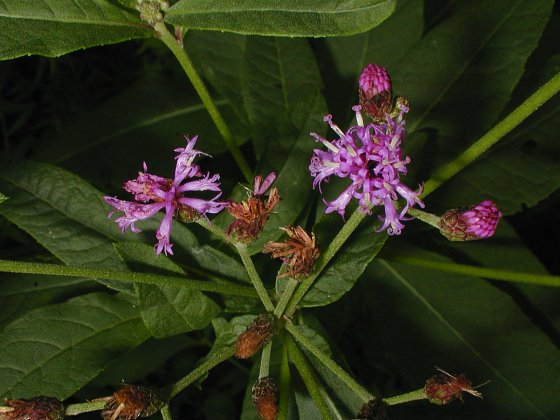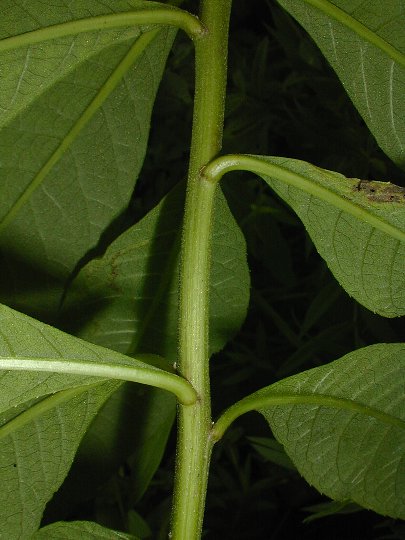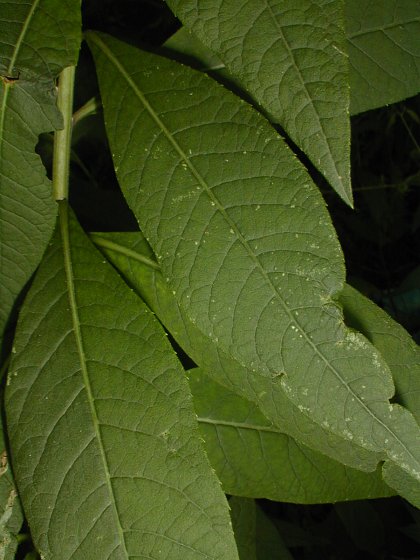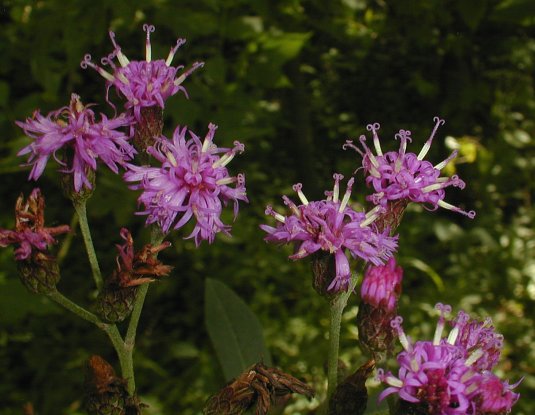Description: This perennial plant is about 3-7' tall and usually unbranched, except near the inflorescence. The central stem is light green or purplish green, terete, and nearly glabrous to pubescent. The alternate leaves are densely to moderately distributed along the stem, spreading widely in all directions. These leaves are up to 9" long and 2½" across; they are narrowly ovate, lanceolate-oblong, or elliptic in shape, and their margins are serrated. The upper surface of each leaf is dark green and glabrous (or nearly so); the lower surface is a lighter shade of green and glabrous, sparsely pubescent, or somewhat hairy. The base of each leaf has a short petiole, or it is sessile.

The central stem terminates in a flat-headed panicle of flowerheads spanning 6-16" across. The base of each flowerhead consists of a short cylinder of appressed floral bracts (phyllaries) in several series spanning about 5 mm. across; the floral bracts are dark green, purplish green, or brown, broadly ovate in shape, and often finely pubescent or ciliate along their margins. The apex of each flowerhead consists of 10-30 disk florets and no ray florets. The magenta corolla of each disk floret is tubular with 5 recurved narrow lobes, while the exerted style is bifurcated and strongly recurved. The branches of the panicle and peduncles of the flowerheads are usually finely short-pubescent. The blooming period occurs from late summer to early fall and lasts about 1–1½ months. There is no noticeable floral scent. Each disk floret is replaced by a small achene that is gray or brown and bullet-shaped; the apex of each achene has a small tuft of both short and long hair hairs (or bristles) that are pale purple to tawny. These achenes are distributed by the wind. The root system consists of short thick rhizomes with fibrous roots below. Small clumps of plants are produced from the rhizomes.

Cultivation:
The preference is full sun to light shade, moist to mesic conditions,
and soil containing loam, clay-loam, silt-loam, or
sandy loam. Plants growing in sunny areas require more moisture than
those growing in the shade.
Range & Habitat:
The native Tall Ironweed is common in southern Illinois, while in the
rest of the
state it is occasional to absent (see Distribution
Map). Habitats include open woodlands, woodland
borders, thickets, areas along woodland paths, swamps, riverbottom
prairies, seeps and springs, pastures, and abandoned fields. In
woodlands, this plant requires occasional disturbance to prevent
excessive shade from neighboring trees. Tall Ironweed is found in
wooded areas to a greater extent than other Vernonia spp.
(Ironweed species) in Illinois, but it also occurs in moist open areas.

Faunal Associations: The nectar of the flowers attracts bee flies, butterflies, skippers, and various bees (primarily long-tongued bees). Some bees also collect pollen for their larvae. The caterpillars of various moths feed on Vernonia spp. (Ironweed species), particularly the pith of their stems and their roots. These species include Carmenta bassiformis (Eupatorium Borer Moth), Papaipema cerussata (Ironweed Borer Moth), Papaipema limpida (another Ironweed Borer Moth), Perigea xanthioides (Red Groundling), Polygrammodes flavidalis (Pyralid Moth sp.), and Polygrammodes langdonalis (Pyralid Moth sp.). Another insect, Aphis vernoniae (Ironweed Aphid), sucks juices from the upper stems and leaf undersides. Other insects feeders include the larvae of Asphondylia vernoniae (Ironweed Bud Midge) and Youngomyia podophyllae (Ironweed Blossum Midge), which form galls on the buds and flowerheads respectively. Both Oecanthus quadripunctatus (Four-Spotted Tree Cricket) and Conocephalus brevipennis (Short-winged Meadow Katydid) have been observed feeding on the flowerheads of Tall Ironweed (Gangwere, 1961). Because of the bitter foliage, mammalian herbivores shun Ironweed species as a food source. As a result, these plants can become more abundant in pastures over time.

Photographic
Location:
The edge of a small woodland in Urbana, Illinois.
Comments:
Across its range, Tall Ironweed is a rather variable species. Different
populations of plants can vary in the number of disk florets per
flowerhead, the width of the leaves, and the hairiness of the stems and
leaf undersides. Tall Ironweed also hybridizes with other Vernonia
spp. (Ironweeds), especially Vernonia missurica
(Missouri Ironweed). The latter hybrid is referred to as Vernonia
× illinoensis (Illinois Ironweed). Illinois Ironweed
typically has flowerheads with 30-35 disk florets and is more hairy
than Tall Ironweed. Missouri Ironweed has flowerheads with 35-50 disk
florets and it is more hairy than Tall Ironweed; both stems and leaf
undersides of Missouri Ironweed are often white-woolly from the
abundance of these hairs. Another species, Vernonia
fasciculata (Smooth Ironweed), has about the same number of
disk florets in its flowerheads as Tall Ironweed (less than 30), but it
is usually smaller in size and its stems are hairless. Unlike Tall
Ironweed, Smooth Ironweed often has dark dots on the underside of its
hairless leaves. A scientific synonym of Tall Ironweed is Vernonia
altissima.